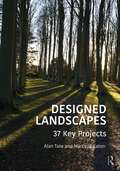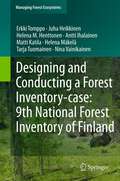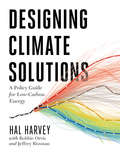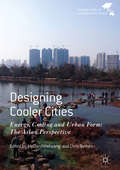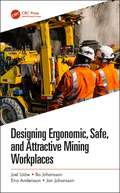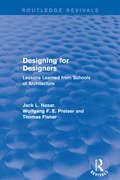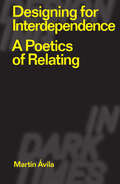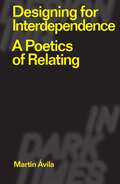- Table View
- List View
Designed Landscapes: 37 Key Projects
by Alan Tate Marcella EatonDesigned Landscapes is a case-by-case study of 37 significant, existing works of landscape design worldwide, largely constructed since the Renaissance. Being an informative and easy-to-read reference volume for practitioners and students alike, it presents key precedents in landscape architecture using site plans and recent photographs to showcase each project. Organised and presented in 12 sections based on project type, each project is examined based on date, previous site condition, designer(s), design intentions, current composition, unique features, ownership and management, and comparable projects. Each chapter offers an insightful critique of the featured projects. Written by the authors of Great City Parks, the book posits that these carefully selected key projects have maintained their status throughout the ages because they express values and design intentions that continue to inform the practice of the landscape architecture in the present day. The book concludes with a ten-point summary of lessons for professional practice gleaned from the studies. Including a wide range of case studies from countries including many in western Europe, the United States, Canada, India, Japan and China, and lavishly illustrated with over 200 full-colour images, the book is a must-have volume for anyone interested in the history and current practice of landscape architecture.
Designed Landscapes: 37 Key Projects
by Alan Tate Marcella EatonDesigned Landscapes is a case-by-case study of 37 significant, existing works of landscape design worldwide, largely constructed since the Renaissance. Being an informative and easy-to-read reference volume for practitioners and students alike, it presents key precedents in landscape architecture using site plans and recent photographs to showcase each project. Organised and presented in 12 sections based on project type, each project is examined based on date, previous site condition, designer(s), design intentions, current composition, unique features, ownership and management, and comparable projects. Each chapter offers an insightful critique of the featured projects. Written by the authors of Great City Parks, the book posits that these carefully selected key projects have maintained their status throughout the ages because they express values and design intentions that continue to inform the practice of the landscape architecture in the present day. The book concludes with a ten-point summary of lessons for professional practice gleaned from the studies. Including a wide range of case studies from countries including many in western Europe, the United States, Canada, India, Japan and China, and lavishly illustrated with over 200 full-colour images, the book is a must-have volume for anyone interested in the history and current practice of landscape architecture.
Designer’s Guide to Lab Practice (Bio Design)
by Assia CrawfordThis book explores the growing field of bio-design through interdisciplinary creative practice. The volume illustrates a range of experimental working techniques while offering a foundational understanding of lab practice principles. The book highlights the myriad of opportunities presented by microorganisms that have reshaped the planet and made it habitable. The book provides an account of the creation of living materials from the point of view of an architectural design practitioner. The transition from traditional design practice to laboratory investigation is captured, highlighting strategies of creating partnerships across a range of fields. The book demonstrates laboratory methods and ways of investigating the development of living materials and celebrates the growing body of practitioners, scientists, activists and anthropologists who are reimagining new strategies for addressing contemporary environmental challenges. Designer's Guide to Lab Practice looks at ways in which integrating living components with needs of their own would not only help offset the environmental impact that we have on our planet but could also create a closer relationship with nature. It is a working manual as well as a guide to emerging practitioners seeking to transition into a field that is yet to be defined and that offers the promise of a new era of human habitat making as a direct response to the looming ecological crisis.
Designer’s Guide to Lab Practice (Bio Design)
by Assia CrawfordThis book explores the growing field of bio-design through interdisciplinary creative practice. The volume illustrates a range of experimental working techniques while offering a foundational understanding of lab practice principles. The book highlights the myriad of opportunities presented by microorganisms that have reshaped the planet and made it habitable. The book provides an account of the creation of living materials from the point of view of an architectural design practitioner. The transition from traditional design practice to laboratory investigation is captured, highlighting strategies of creating partnerships across a range of fields. The book demonstrates laboratory methods and ways of investigating the development of living materials and celebrates the growing body of practitioners, scientists, activists and anthropologists who are reimagining new strategies for addressing contemporary environmental challenges. Designer's Guide to Lab Practice looks at ways in which integrating living components with needs of their own would not only help offset the environmental impact that we have on our planet but could also create a closer relationship with nature. It is a working manual as well as a guide to emerging practitioners seeking to transition into a field that is yet to be defined and that offers the promise of a new era of human habitat making as a direct response to the looming ecological crisis.
Designers Visionaries and Other Stories: A Collection of Sustainable Design Essays
by Jonathan ChapmanDesigners, Visionaries and Other Stories unpacks the complex and crucial debates surrounding sustainable design to deliver a compelling manifesto for change, at a time of looming ecological crisis, mounting environmental legislation and limited progress. This is a book about sustainable design, by the leading sustainable design thinkers, for creative practitioners, professionals, students and academics. This challenging work provides the reader with a rich resource of future visions, critical propositions, creative ideas and design strategies for working towards a sustainable tomorrow, today. The authors boldly present alternative understandings of sustainable design, to curate a challenging, sometimes uncomfortable and always provocative, collection of essays by some of the worlds leading sustainable design thinkers. The result is an impacting and polemical anthology that reinvigorates the culture of critique that, in previous years, has empowered design with the qualities of social, environmental and economic revolution.
Designers Visionaries and Other Stories: A Collection of Sustainable Design Essays
by Jonathan ChapmanDesigners, Visionaries and Other Stories unpacks the complex and crucial debates surrounding sustainable design to deliver a compelling manifesto for change, at a time of looming ecological crisis, mounting environmental legislation and limited progress. This is a book about sustainable design, by the leading sustainable design thinkers, for creative practitioners, professionals, students and academics. This challenging work provides the reader with a rich resource of future visions, critical propositions, creative ideas and design strategies for working towards a sustainable tomorrow, today. The authors boldly present alternative understandings of sustainable design, to curate a challenging, sometimes uncomfortable and always provocative, collection of essays by some of the worlds leading sustainable design thinkers. The result is an impacting and polemical anthology that reinvigorates the culture of critique that, in previous years, has empowered design with the qualities of social, environmental and economic revolution.
Designing a Sustainable Financial System: Development Goals and Socio-Ecological Responsibility (Palgrave Studies in Sustainable Business In Association with Future Earth)
by Thomas Walker Stéfanie D. Kibsey Rohan CrichtonThis edited collection brings together leading theoretical and applied research with the intent to design a sustainable global financial future. The contributors argue that our world cannot move toward sustainability, address climate change, reverse environmental degradation, and improve human well-being without aligning the financial system with sustainable development goals like those outlined by the United Nations. Such a system would: a) be environmentally and socially responsible; b) align with planetary boundaries; c) manage natural resources sustainably; d) avoid doing more harm than good; and e) be resilient and adaptable to changing conditions. The overarching theme in this collection of chapters is a response to the worldwide, supranational sustainable finance discussions about how we can transition to a new socio-ecological system where finance, human well-being, and planetary health are recognized as being highly intertwined.
Designing and Conducting a Forest Inventory - case: 9th National Forest Inventory of Finland (Managing Forest Ecosystems #22)
by Erkki Tomppo Juha Heikkinen Helena M. Henttonen Antti Ihalainen Matti Katila Helena Mäkelä Tarja Tuomainen Nina VainikainenThis book demonstrates in detail all phases of the 9th National Forest Inventory of Finland (1996–2003): the planning of the sampling design, measurements, estimation methods and results. The inventory knowledge accumulated during almost one hundred years is consolidated in the book. The purpose of the numerous examples of results is to demonstrate the diversity of the estimates and content of a national forest inventory. The most recent results include the assessment of the indicators describing the biodiversity of forests. The Finnish NFI has been and is a model for many countries worldwide. The methods and results of the book are set in the international context and are applicable globally. The book provides a valuable information source for countries, institutions and researchers planning own inventories as well as modifying the existing ones, or seeking the applicable definitions and estimation methods to use in their own inventories.
Designing Climate Solutions: A Policy Guide for Low-Carbon Energy
by Hal Harvey Robbie Orvis Jeffrey RissmanWith the effects of climate change already upon us, the need to cut global greenhouse gas emissions is nothing less than urgent. It’s a daunting challenge, but the technologies and strategies to meet it exist today. A small set of energy policies, designed and implemented well, can put us on the path to a low carbon future. Energy systems are large and complex, so energy policy must be focused and cost-effective. One-size-fits-all approaches simply won’t get the job done. Policymakers need a clear, comprehensive resource that outlines the energy policies that will have the biggest impact on our climate future, and describes how to design these policies well.Designing Climate Solutions: A Policy Guide for Low-Carbon Energy is the first such guide, bringing together the latest research and analysis around low carbon energy solutions. Written by Hal Harvey, CEO of the policy firm Energy Innovation, with Robbie Orvis and Jeffrey Rissman of Energy Innovation, Designing Climate Solutions is an accessible resource on lowering carbon emissions for policymakers, activists, philanthropists, and others in the climate and energy community. In Part I, the authors deliver a roadmap for understanding which countries, sectors, and sources produce the greatest amount of greenhouse gas emissions, and give readers the tools to select and design efficient policies for each of these sectors. In Part II, they break down each type of policy, from renewable portfolio standards to carbon pricing, offering key design principles and case studies where each policy has been implemented successfully.We don’t need to wait for new technologies or strategies to create a low carbon future—and we can’t afford to. Designing Climate Solutions gives professionals the tools they need to select, design, and implement the policies that can put us on the path to a livable climate future.
Designing Cooler Cities: The Asian Perspective (PDF)
by Ali Cheshmehzangi Chris ButtersThis edited book surveys the major sustainability challenges facing Asian cities, in particular those related to urban energy and city cooling. The book discusses the key concepts and issues involved, addressing the three levels of micro (individual buildings), meso (neighbourhoods/districts) and macro (whole or large parts of cities). It illustrates different paradigms of urban development and explores how to create cooler cities by applying integrated sustainable design and planning on all three levels, bridging the gap between specialist approaches by highlighting both built projects, processes, and research. It also raises questions about prevalent paradigms of urban development as well as topics relating to urban district cooling solutions, sustainable construction materials, and processes towards effective delivery of sustainable cities. Providing cutting edge insights into hot climate cities in Asia, this text is also pertinent for the study of cities in other world regions, notably in developing countries, and of broad relevance to sustainable urban planning in all contexts.
Designing Ergonomic, Safe, and Attractive Mining Workplaces
by Joel Lööw Bo Johansson Eira Andersson Jan JohanssonThe mining industry has experienced important improvements with regard to its safety record and work environment. But there is still room for further improvement and the mining industry now faces the challenge of securing a future workforce: The current workforce is aging, and mining work increasingly requires a more qualified workforce. Designing Ergonomic, Safe, and Attractive Mining Workplaces seeks to give an understanding of what must be considered in the design of mining workplaces. By reviewing and discussing the historic and current development of the mining industry as well as problems related to the safety, ergonomics, and attractiveness of mining workplaces, it demonstrates that the challenges facing the mining industry often need to be solved on a case-to-case basis. The processes through which these issues are managed are of significant importance. To facilitate a proactive approach, the book covers the principles of systematic work environment management, together with examples of methods for risk management and work environment monitoring. It introduces a systematic and iterative design and planning method for the mining industry. This method acknowledges that all relevant stakeholders must be able to influence the design of ergonomic, safe, and attractive mining workplaces. Features Takes a holistic and sociotechnical approach to current and future problems of the mining industry, which normally are dealt with in isolation or through technology Reviews historic, current, and future issues in the mining industry with regards to workplace attractiveness, health, safety, mechanization, automation, and work organization Provides several examples of these issues and attempts to address them (successfully and unsuccessfully) Covers the principles of systematic work environment management together with examples of methods for risk management and work environment monitoring for pro-actively dealing with work environment issues Introduces a systematic and iterative design and planning method for the mining industry that aims to avoid problems of traditional planning approaches and increase stakeholder and employee participation
Designing Ergonomic, Safe, and Attractive Mining Workplaces
by Joel Lööw Bo Johansson Eira Andersson Jan JohanssonThe mining industry has experienced important improvements with regard to its safety record and work environment. But there is still room for further improvement and the mining industry now faces the challenge of securing a future workforce: The current workforce is aging, and mining work increasingly requires a more qualified workforce. Designing Ergonomic, Safe, and Attractive Mining Workplaces seeks to give an understanding of what must be considered in the design of mining workplaces. By reviewing and discussing the historic and current development of the mining industry as well as problems related to the safety, ergonomics, and attractiveness of mining workplaces, it demonstrates that the challenges facing the mining industry often need to be solved on a case-to-case basis. The processes through which these issues are managed are of significant importance. To facilitate a proactive approach, the book covers the principles of systematic work environment management, together with examples of methods for risk management and work environment monitoring. It introduces a systematic and iterative design and planning method for the mining industry. This method acknowledges that all relevant stakeholders must be able to influence the design of ergonomic, safe, and attractive mining workplaces. Features Takes a holistic and sociotechnical approach to current and future problems of the mining industry, which normally are dealt with in isolation or through technology Reviews historic, current, and future issues in the mining industry with regards to workplace attractiveness, health, safety, mechanization, automation, and work organization Provides several examples of these issues and attempts to address them (successfully and unsuccessfully) Covers the principles of systematic work environment management together with examples of methods for risk management and work environment monitoring for pro-actively dealing with work environment issues Introduces a systematic and iterative design and planning method for the mining industry that aims to avoid problems of traditional planning approaches and increase stakeholder and employee participation
Designing for Designers: Lessons Learned from Schools of Architecture (Routledge Revivals)
by Wolfgang F. Preiser Jack Nasar Thomas FisherFirst published in 2007, this book examines the designs of seventeen architecture and design schools and answers questions such as: How has architectural education evolved and what is its future? Are architectural schools discernible types of designs and what are their effects on those who experience them? What lessons can be learned from evaluations of recently completed school buildings and what guidance do they provide for the design of future ones? Included in the multiple approaches to evaluation are examinations of the history of architectural education and building form; typologies of school for architecture; and the systematic user evaluations of the aesthetics, function, and technology which reveal the strengths to encourage and weaknesses to avoid in future designs. While offering specific guidelines for schools of design, it also includes findings that extend beyond the walls of design schools and can be applied to everything from the interiors of educational and campus buildings to planning offices and gathering places to build communities. This book will make readers more aware of problems in architectural interiors and suggest ways to make interiors work better for the building occupants.
Designing for Designers: Lessons Learned from Schools of Architecture (Routledge Revivals)
by Wolfgang F. Preiser Jack Nasar Thomas FisherFirst published in 2007, this book examines the designs of seventeen architecture and design schools and answers questions such as: How has architectural education evolved and what is its future? Are architectural schools discernible types of designs and what are their effects on those who experience them? What lessons can be learned from evaluations of recently completed school buildings and what guidance do they provide for the design of future ones? Included in the multiple approaches to evaluation are examinations of the history of architectural education and building form; typologies of school for architecture; and the systematic user evaluations of the aesthetics, function, and technology which reveal the strengths to encourage and weaknesses to avoid in future designs. While offering specific guidelines for schools of design, it also includes findings that extend beyond the walls of design schools and can be applied to everything from the interiors of educational and campus buildings to planning offices and gathering places to build communities. This book will make readers more aware of problems in architectural interiors and suggest ways to make interiors work better for the building occupants.
Designing for Interdependence: A Poetics of Relating (Designing in Dark Times)
by Martín ÁvilaChallenging the dominant design paradigm that centres humanity in its practice, Designing for Interdependence puts forward an ecocentric mode of designing that privileges a harmonious relationship between all life forms that share our planet. This book is about the practice of designing and design's capacity to relate (or not) to beings of all kinds, human and others, in ways that are life-affirming. Sensitive to power differentials and the responsibility that this entails, Martín Ávila develops the notion of alter-natives, a concept that exposes the alterity of artificial things and the potential of these things to participate in the sustainment of natural environments. He proposes a design practice that encompasses humans, artificial things and other-than-human species in a 'poetics of relating', and provides methods that support the rewilding necessary for maintaining cultural and biological diversity and the stabilization of planetary dynamics. The book features real-life project case studies that illustrate some of the political-ecological implications of an ecocentric paradigm, which can help us to imagine alternative modes of relating to local environments and alternative modes of inter-species cohabitation.Avoiding dualistic thinking and the dichotomies harmful-benefit, construction-destruction, natural-artificial and life-death, Ávila pursues the work of caring for how our mattering through design can become constructive in creating more-than-human ecologies.
Designing for Interdependence: A Poetics of Relating (Designing in Dark Times)
by Martín ÁvilaChallenging the dominant design paradigm that centres humanity in its practice, Designing for Interdependence puts forward an ecocentric mode of designing that privileges a harmonious relationship between all life forms that share our planet. This book is about the practice of designing and design's capacity to relate (or not) to beings of all kinds, human and others, in ways that are life-affirming. Sensitive to power differentials and the responsibility that this entails, Martín Ávila develops the notion of alter-natives, a concept that exposes the alterity of artificial things and the potential of these things to participate in the sustainment of natural environments. He proposes a design practice that encompasses humans, artificial things and other-than-human species in a 'poetics of relating', and provides methods that support the rewilding necessary for maintaining cultural and biological diversity and the stabilization of planetary dynamics. The book features real-life project case studies that illustrate some of the political-ecological implications of an ecocentric paradigm, which can help us to imagine alternative modes of relating to local environments and alternative modes of inter-species cohabitation.Avoiding dualistic thinking and the dichotomies harmful-benefit, construction-destruction, natural-artificial and life-death, Ávila pursues the work of caring for how our mattering through design can become constructive in creating more-than-human ecologies.
Designing for Longevity: Expert Strategies for Creating Long-Lasting Products
by Louise Møller Haase Linda Nhu LaursenProduct longevity is one of the cornerstones in the transition towards a more sustainable society and a key driver for the circular economy model. This book provides designers, developers, and creators with five distinctive expert strategies, detailed case studies, action guides and worksheets that support both beginning and advanced design practitioners in creating new product concepts with long-lasting strategic fits. Designing for Longevity shows how expert design teams create original and long-lasting product concepts from the early development phase. It focuses on integrating business knowledge, market conditions, company capabilities, technical possibilities and user needs into product concepts to make better strategic decisions. It demonstrates how, for products to be durable, designers must create a long-lasting strategic fit for the customer, company, and market. Key case studies of products such as Bang & Olufsen’s A9, LEGO Ninjago and Friends and Coloplasts’ Sensura Mio, among others, offer readers inspiration, guidance and real-world insights from design teams showing how the strategies can be applied in practice. Action guidelines and worksheets encourage broad, analytical problem-solving to identify and think through challenges at the early concept stage. Beautifully designed and illustrated in full colour throughout, this book combines original research and the hands-on tools and strategies that design practitioners need to create useful, sustainable products.
Designing for Longevity: Expert Strategies for Creating Long-Lasting Products
by Louise Møller Haase Linda Nhu LaursenProduct longevity is one of the cornerstones in the transition towards a more sustainable society and a key driver for the circular economy model. This book provides designers, developers, and creators with five distinctive expert strategies, detailed case studies, action guides and worksheets that support both beginning and advanced design practitioners in creating new product concepts with long-lasting strategic fits. Designing for Longevity shows how expert design teams create original and long-lasting product concepts from the early development phase. It focuses on integrating business knowledge, market conditions, company capabilities, technical possibilities and user needs into product concepts to make better strategic decisions. It demonstrates how, for products to be durable, designers must create a long-lasting strategic fit for the customer, company, and market. Key case studies of products such as Bang & Olufsen’s A9, LEGO Ninjago and Friends and Coloplasts’ Sensura Mio, among others, offer readers inspiration, guidance and real-world insights from design teams showing how the strategies can be applied in practice. Action guidelines and worksheets encourage broad, analytical problem-solving to identify and think through challenges at the early concept stage. Beautifully designed and illustrated in full colour throughout, this book combines original research and the hands-on tools and strategies that design practitioners need to create useful, sustainable products.
Designing for the Circular Economy
by Martin CharterThe circular economy describes a world in which reuse through repair, reconditioning and refurbishment is the prevailing social and economic model. The business opportunities are huge but developing product and service offerings and achieving competitive advantage means rethinking your business model from early creativity and design processes, through marketing and communication to pricing and supply. Designing for the Circular Economy highlights and explores ‘state of the art’ research and industrial practice, highlighting CE as a source of: new business opportunities; radical business change; disruptive innovation; social change; and new consumer attitudes. The thirty-four chapters provide a comprehensive overview of issues related to product circularity from policy through to design and development. Chapters are designed to be easy to digest and include numerous examples. An important feature of the book is the case studies section that covers a diverse range of topics related to CE, business models and design and development in sectors ranging from construction to retail, clothing, technology and manufacturing. Designing for the Circular Economy will inform and educate any companies seeking to move their business models towards these emerging models of sustainability; organizations already working in the circular economy can benchmark their current activities and draw inspiration from new applications and an understanding of the changing social and political context. This book will appeal to both academia and business with an interest in CE issues related to products, innovation and new business models.
Designing for the Circular Economy
by Martin CharterThe circular economy describes a world in which reuse through repair, reconditioning and refurbishment is the prevailing social and economic model. The business opportunities are huge but developing product and service offerings and achieving competitive advantage means rethinking your business model from early creativity and design processes, through marketing and communication to pricing and supply. Designing for the Circular Economy highlights and explores ‘state of the art’ research and industrial practice, highlighting CE as a source of: new business opportunities; radical business change; disruptive innovation; social change; and new consumer attitudes. The thirty-four chapters provide a comprehensive overview of issues related to product circularity from policy through to design and development. Chapters are designed to be easy to digest and include numerous examples. An important feature of the book is the case studies section that covers a diverse range of topics related to CE, business models and design and development in sectors ranging from construction to retail, clothing, technology and manufacturing. Designing for the Circular Economy will inform and educate any companies seeking to move their business models towards these emerging models of sustainability; organizations already working in the circular economy can benchmark their current activities and draw inspiration from new applications and an understanding of the changing social and political context. This book will appeal to both academia and business with an interest in CE issues related to products, innovation and new business models.
Designing for the Climate Emergency: A Guide for Architecture Students
by Sofie Pelsmakers Aidan Hoggard Urszula Kozminska Elizabeth DonovanWe are in a climate emergency. Architects must be part of the radical change needed. This book guides architecture student to create truly sustainable designs. Demonstrating holistic design approaches through 10 key themes, it guides students through the different stages of the design process in five illustrated chapters. Reflecting the years of study, it provides step-changes towards eventual architecture practice. Unique features include key checklists, case studies, student examples and an extensive glossary.
Designing for the Climate Emergency: A Guide for Architecture Students
by Sofie Pelsmakers Aidan Hoggard Urszula Kozminska Elizabeth DonovanWe are in a climate emergency. Architects must be part of the radical change needed. This book guides architecture student to create truly sustainable designs. Demonstrating holistic design approaches through 10 key themes, it guides students through the different stages of the design process in five illustrated chapters. Reflecting the years of study, it provides step-changes towards eventual architecture practice. Unique features include key checklists, case studies, student examples and an extensive glossary.
Designing for Zero Waste: Consumption, Technologies and the Built Environment
by Steffen Lehmann Robert CrockerDesigning for Zero Waste is a timely, topical and necessary publication. Materials and resources are being depleted at an accelerating speed and rising consumption trends across the globe have placed material efficiency, waste reduction and recycling at the centre of many government policy agendas, giving them an unprecedented urgency. While there has been a considerable literature addressing consumption and waste reduction from different disciplinary perspectives, the complex nature of the problem requires an increasing degree of interdisciplinarity. Resource recovery and the optimisation of material flow can only be achieved alongside and through behaviour change to reduce the creation of material waste and wasteful consumption. This book aims to develop a more robust understanding of the links between lifestyle, consumption, technologies and urban development.
Designing for Zero Waste: Consumption, Technologies and the Built Environment
by Steffen Lehmann Robert CrockerDesigning for Zero Waste is a timely, topical and necessary publication. Materials and resources are being depleted at an accelerating speed and rising consumption trends across the globe have placed material efficiency, waste reduction and recycling at the centre of many government policy agendas, giving them an unprecedented urgency. While there has been a considerable literature addressing consumption and waste reduction from different disciplinary perspectives, the complex nature of the problem requires an increasing degree of interdisciplinarity. Resource recovery and the optimisation of material flow can only be achieved alongside and through behaviour change to reduce the creation of material waste and wasteful consumption. This book aims to develop a more robust understanding of the links between lifestyle, consumption, technologies and urban development.
Designing Futures: Speculation, Critique, Innovation
by Benedikt Groß Eileen MandirThe ability to imagine different possible futures and the will to influence the course of events are deeply human. These ideas about the future can also determine which of the many possible futures will become reality. Designing futures therefore means that by creating and communicating potential scenarios, you can shape the futures of your fellow human beings and influence the course of events. Design is becoming more strategic as a discipline, moving away from 'making things beautiful' to 'thinking creatively'. This book provides designers with the methods and tools they need to develop discussable and tangible scenarios. It also outlines ways for creative people, activists and decision-makers in politics, science and the wider society to imagine more desirable futures.- With over 500 illustrations.- Case studies from across the world.- Foreword by Riel Miller, senior fellow at the École des Ponts Business School, the University of Stavanger and the University of New Brunswick.
